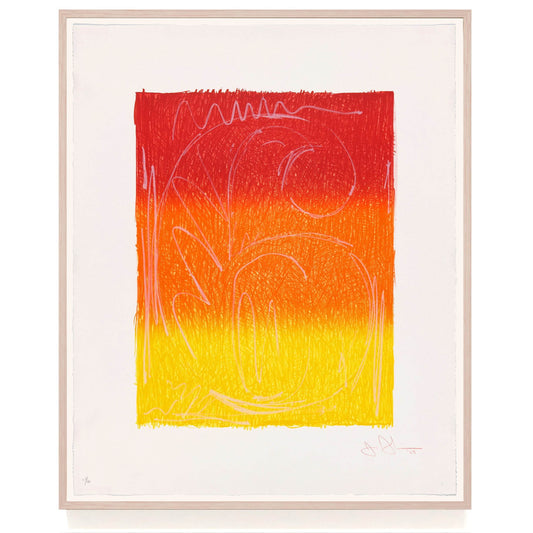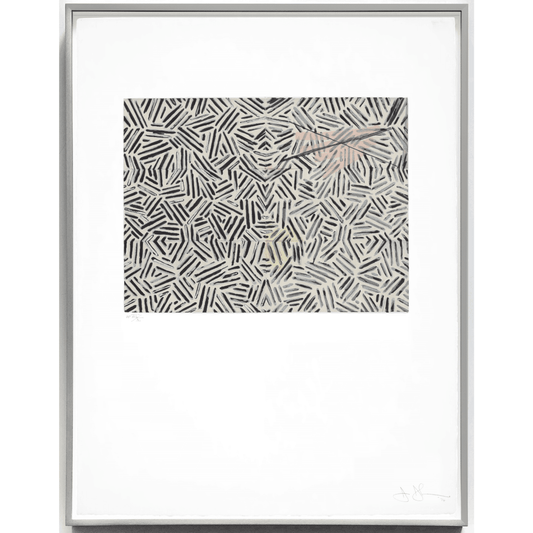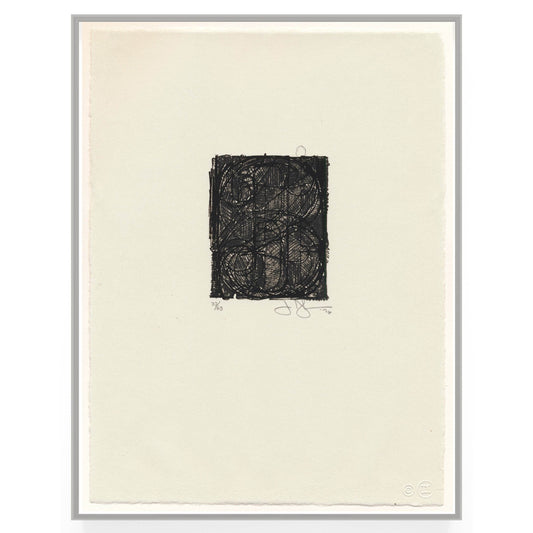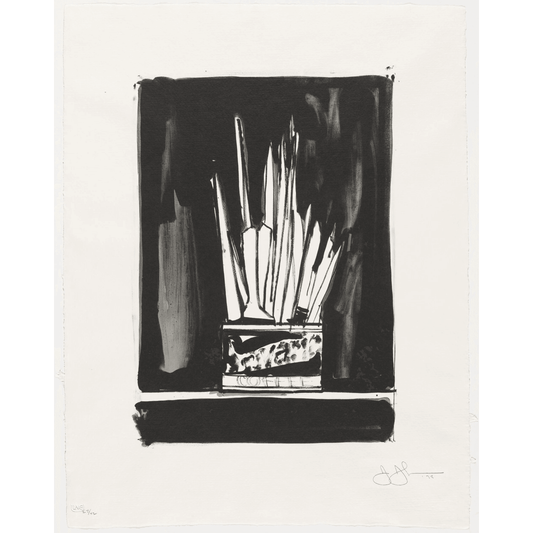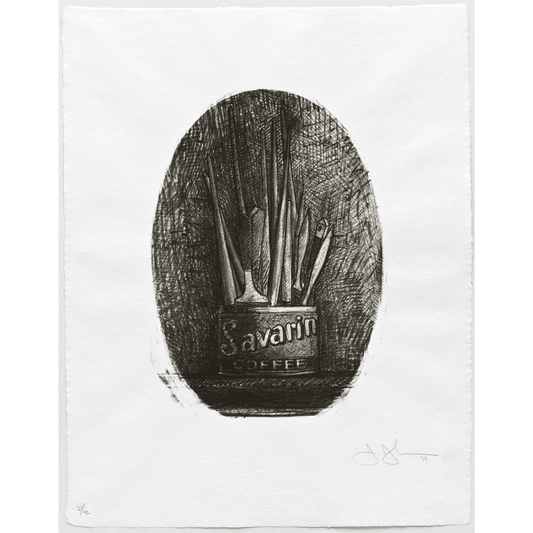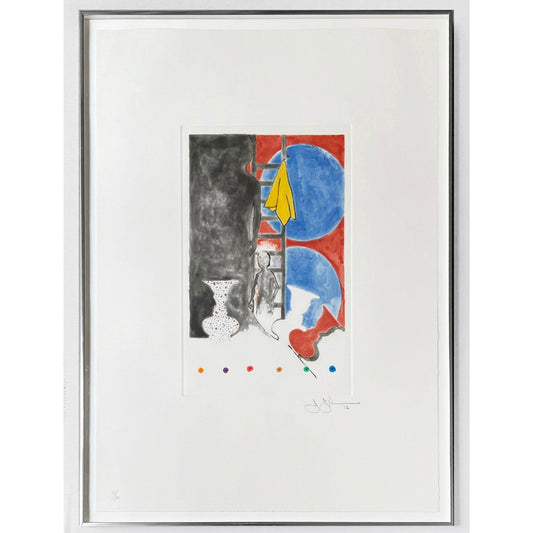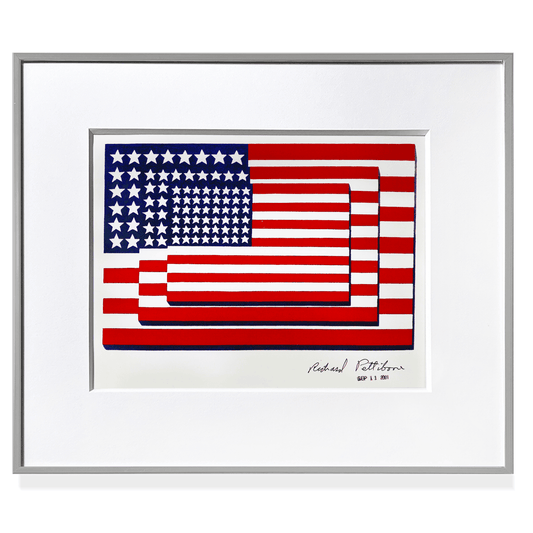
Collecting Works on Paper
Share
Exploring Works on Paper
The term works on paper encompasses a wide array of fine art expressions, from drawings and paintings to prints and mixed-media compositions. Traditionally, artists have created works on paper as a space for experimentation—testing new techniques, refining ideas, or capturing fleeting moments with the immediacy of pencil, charcoal, or ink. This process offers collectors an intimate glimpse into an artist’s creative journey, as if peering directly into their thoughts. Increasingly, artists embrace works on paper as a primary medium, using it to push the boundaries of their artistic practice.
 Ed Ruscha Blue Scream, 1964 tempera and pencil on paper
Ed Ruscha Blue Scream, 1964 tempera and pencil on paper
Artists renowned for their versatility across multiple media often create compelling bodies of works on paper. For example, monumental sculptor Richard Serra translated his signature physicality into textured compositions using thick layers of paintstick and charcoal. Ed Ruscha, known for his conceptual body of work, incorporates unconventional materials—such as gunpowder, Pepto Bismol and even caviar—into his paper-based works to reflect the nuances of contemporary life.
Over his 7 decade career, Jasper Johns has created about 450 limited edition fine art prints and and about an equal number of paintings. With his Crosshatch/Untitled prints, Jasper Johns sought to evoke a “new form", one that is growing and splitting in new visual directions. "The Untitled title has to do with the image of something bursting through its skin, which is what they do. You have all those shells where the back splits and they've emerged. And basically that kind of splitting form is what I tried to suggest."
In Jasper Johns Untitled (ULAE 186), 1977, a color screenprint co-published by Johns and Simca Print Artists, Inc., the crosshatch lines are in primary colors, red, yellow and blue; the impression is particularly vibrant as the impression is museum quality and looks as good today as it did when Johns created this limited edition gem in almost 50 years ago.
 Jasper Johns Untitled (ULAE 186), 1977, 9 color silkscreen on Rives Moulin Du Gue paper
Jasper Johns Untitled (ULAE 186), 1977, 9 color silkscreen on Rives Moulin Du Gue paper
Vija Celmins’ hyper-detailed drawings offer an intimate, almost magnified perspective on nature, while Cy Twombly’s gestural compositions reveal recurring motifs and stylistic flourishes that define his artistic language. Sam Gilliam, celebrated for his innovative draped canvases, explores color and form on paper as a precursor to his most acclaimed works.
Historically, many great artists have created works on paper as a vital part of their oeuvre. Pierre-Auguste Renoir, inspired by the Old Masters he studied near the Louvre, created delicate pencil sketches early in his career. Edgar Degas, known for his dynamic depictions of ballet dancers, carried pastels and pencils with him to capture movement in spontaneous sketches. Fernand Léger’s architectural background influenced his bold, mechanical compositions.
Best known as a master of kinetic sculpture, Alexander Calder began creating gouache works on paper in 1945 for a show at the legendary Kootz Gallery. Alexander Calder’s series of gouaches quickly gained popularity earning acclaim from both the public and critics, who saw Alexander Calder as a potential rival to Klee and Miró. They were so successful that Calder continued to create unique works on paper until his passing in 1976.
Alexander Calder African Scene, 1966, is a unique ink on paper registered in the archives of the Calder Foundation, New York, under application number A05112.
Calder's gouaches and works on paper capture a sense of playfulness and humor—qualities that Calder upheld throughout his career, often reinterpreting his iconic visual vocabulary in innovative ways. Alexander Calder African Scene, 1966 is unique like every work of art created by the Artist aside from his graphics. African Scene reflects Calder’s deep appreciation for African and Oceanic art.
African Scene, 1966 by Alexander Calder marks a significant moment in his artistic journey; this unique ink on paper drawing showcases Calder's fascination with family and African art. In African Scene, Calder blends African iconography with a whimsical touch, featuring exaggerated portrayals of nude male and female figures, each holding different objects—a cart and an umbrella.
Why Collect Works on Paper?
Works on paper offer a compelling and accessible entry point into the world of art collecting. Often less expensive than paintings and sculpture, they allow art collectors to acquire significant works of art by established artists while enabling seasoned collectors to deepen their engagement with an artist’s practice. Despite their relative accessibility, works on paper are by no means limited in artistic or monetary value—exceptional pieces can reach prices in the millions, underscoring their importance within the art market. Jasper Johns Set of 10 Numbers, 1969, Jasper Johns: Mind/Mirror, The Philadelphia Museum of Art
Jasper Johns Set of 10 Numbers, 1969, Jasper Johns: Mind/Mirror, The Philadelphia Museum of Art
One of the most appealing aspects of collecting works on paper is the diversity of media and techniques employed by artists. Drawings, for instance, range from delicate graphite sketches and expressive charcoal studies to bold ink compositions and intricate colored pencil renderings. Many artists use gouache, watercolor or pastel to create vibrant works on paper, while mixed-media pieces incorporate elements like collage, acrylic washes, or even unconventional materials such as coffee or gold leaf.
Printmaking also plays a significant role in the world of works on paper. Artists have long experimented with techniques such as etching, lithography, woodcut, screen printing and monotypes to produce multiple impressions of an image, each with subtle variations that make them unique and highly collectible. Some artists, like Jasper Johns, Pablo Picasso and Andy Warhol, create masterful prints that are just as revered as their paintings, while contemporary artists like Frank Stella and Julie Mehretu pushed the boundaries of printmaking with large-scale and experimental approaches. Frank Stella The Fountain, 1992, is a 91 x 292 inch limited edition woodcut, etching, aquatint, relief, screenprint, drypoint and collage on handmade paper published by Tyler Graphics in the collection of The Whitney Museum of American Art.
 Frank Stella The Fountain, 1992, etching, aquatint, relief, screenprint, drypoint & collage on handmade paper, Collection The Whitney Museum of American Art
Frank Stella The Fountain, 1992, etching, aquatint, relief, screenprint, drypoint & collage on handmade paper, Collection The Whitney Museum of American Art
Beyond their artistic merit, works on paper provide a fascinating glimpse into an artist’s creative process. Sketches and studies often reveal the early stages of an idea, offering insight into how compositions evolve over time. In some cases, these preliminary works carry an immediacy and rawness that make them just as compelling as finished masterpieces.
Finally, works on paper are often more manageable in terms of display and conservation. Their smaller scale makes them easier to frame, transport, and store, allowing collectors to build and rotate their collections with relative ease. With proper care—such as UV-protected glass, acid-free matting, and stable humidity levels—these works can be preserved for generations, maintaining both their aesthetic and financial value.
Andy Warhol The Shadow (F&S II. 267), 1981 from Myths Portfolio of 10 Screenprints
Whether drawn to the intimacy of a preparatory sketch, the richness of a hand-pulled print, or the expressiveness of mixed-media compositions, collectors will find that works on paper offer an unparalleled opportunity to connect with an artist’s vision in a deeply personal and enduring way.
Key Terms to Know When Collecting Works on Paper
Starting a collection of works on paper can feel overwhelming, but understanding key terms will help you navigate this fascinating medium with confidence. Here are some common terms to look out for:
Pinholes: Tiny pinpricks, often found at the corners or edges of a sheet, occur when an artist pins the paper down during the creation process. Pin hole can be a both a good thing and sometimes should be avoided. For instance a couple of pinholes on a unique work of paper are not considered problematic, and in fact offer a glimpse into the artist’s working method and do not negatively impact the artwork’s condition or value. However, numerous pinholes on limited edition prints that are not part of the original process are generally not a plus.
Backing Board: A rigid, acid-free board placed behind a work on paper to prevent warping or buckling..
Deckled Edge: Handmade papers often feature a naturally rough or feathered edge, known as a deckle edge. Like artist pinholes, deckled edges do not diminish value; in fact, many artists like Jasper Johns prefer them. Similarly, perforated edges indicate that a sheet was removed from a bound sketchbook or notebook.
Hinges: The method by which a work on paper is attached to a secondary support, such as a mat or backing board, without causing damage. Works hinged at the upper corners can be lifted to reveal the reverse side, while those mounted along all four edges remain fixed in place. Ideally your framer should use archival hinges that are non acidic and adhere the respective hinges with wheat paste glue.
Mats: Today’s acid-free mats help protect paper works, but older mats used by framers for decades in the 20th Century were not archival, and often contained acidic materials that, over time, caused discoloration, staining and when left unchecked significant erosion. In some cases, a conservator may be able to reduce the effects of non archival materials.
Mat Stain: A faint, rust-colored line left behind where an acidic mat once touched the paper, often caused by prolonged exposure to light. Unfortunately, once a work has mat staining, the respective damage cannot be fully erased if the work is conserved, and as a result will always be visible.
Time Staining: The yellowing or darkening of paper, usually outside the mat border and on the extreme edges, due to light exposure. Over time, time staining can become more severe and quite distracting. Often works that are badly time stained are considered less desirable and astute collectors prefer buying works on paper without time staining, Using UV-protective glass or plexiglass helps prevent this damage.
Understanding these terms will allow you to assess the condition of works on paper and make informed collecting decisions.
Joseph K. Levene Fine Art, Ltd., an Internationally recognized Jasper Johns and Andy Warhol authority and Fine Art Advisory, has three decades multifaceted fine art experience and perspective as art dealer, online gallery, fine art executive and art collector. Backed by Joseph K. Levene Fine Art, Ltd.'s expertise and reputation as a leading secondary market art dealer, every item offered and sold in the Joseph K. Levene Fine Art, Ltd. Store is guaranteed for authenticity and condition.
All Fine Art offered and sold by Joseph K. Levene Fine Art, Ltd. is Guaranteed Authentic.

JOSEPH K. LEVENE FINE ART, LTD.
25 Central Park W
New York, New York 10023
212-757-8012
info@josephklevenefineartltd.com



